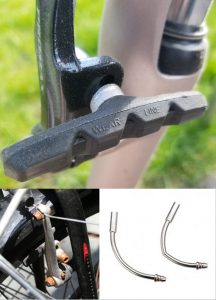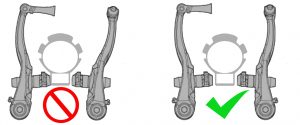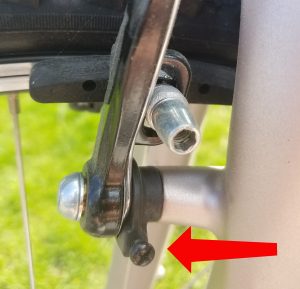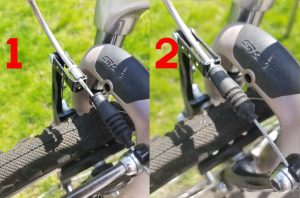by John Brown, HaveFunBiking.com
For those who don’t have disc brakes, the V-brakes on your bike are your greatest single source of control. Take a look below for some tips and tricks on how to adjust your V-brakes.
What Condition is Your V-Brakes In?
Before diving into adjusting your V-brakes, be sure to inspect the brake itself. First thing to check for is excessive corrosion. Highly rusted bolts or springs can break resulting in a crash. Also look for any bent or broken parts. The cradle on the left brake arm is there to hold the brake noodle. If either the v-brakes noodle or cradle are bent (see picture), your brake might not function properly. Also review the brake pads. The easiest way to do this is to remove the wheel. Most pads have lines on them to indicate when they need to be replaced (see picture). Also inspect the pad surface for bits of metal that can damage the bicycles rim.
Cable condition
There are two parts you need to inspect. The Brake cables, and the brake housing. The cable is the wound steel cable that moves when you squeeze the lever. The brake housing can come in many different colors, but is almost always rubber coated and has the cable run through it. Check the cable for rust, frays or kinks and replace if needed. Check the housing for cracks or splitting. Finally, check that the cable moves through the housing freely without resistance.
Rim condition
Spin the wheel and check to see that your rim is straight and round. A wheel should not touch either brake pad as it rotates. It also needs to remain as round as possible. If the rim moves up or down too much, the brake pads can hit the tire, or run off the rim entirely. If the wheel isn’t straight and round, be sure to take it to your local bike shop to have it trued. The other concern when checking the rim is wear. Most rims now have a wear indicator built into the rim in the form of a recessed dot, or a recessed channel around the rim. Once the rim wears past the dot or channel it is time to replace the rim.
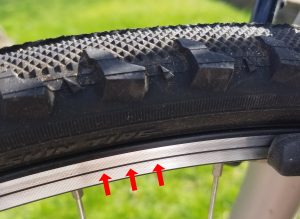
Wear line
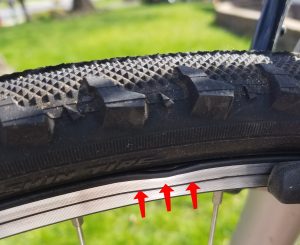
Rim Dent
Pad placement
V-Brake pads get adjusted by way of a 5mm fitting on the back side of the brake pad. The pad sits on a pair of conical washers that allow the pad to be pivoted up to 20 degrees. I find the easiest way to adjust the brake pad is to hold the left brake with your right hand (or the right brake with your left hand) and place your pointer finger along the bottom of the pad (see image). Loosen the 5mm fitting with your hex wrench and use the wrench and your pointer finger to align the pad. To properly align the pad, you want to center the pad between the top and bottom edge of the rim. The pad should be positioned so that no part hits the tire or misses the face of the rim.
Centering
Once the pads are placed properly, the next thing to do is center the brakes. Centering the brakes entails adjusting the brake springs to ensure the pads are both an equal distance from the rim. Adjusting the brake springs is as simple as tightening or loosening the set screws at the bottom of each brake arm. I like to start on the brake arm that has the most adjustment. I determine the amount of adjustment by how far in or out the adjustment screws are in the brake (see image). The only real tricky part of centering the brake is remembering that screwing the adjustment in will move the pad away from the rim (the opposite of what you might expect).
Cable tension on v-brakes
Once the pads are adjusted and the brakes are centered, you need to make sure that the brake engages with the right amount of lever pull. I have found the easiest way to do this is to position the end of the cable noodle on the end of the brake cradle (1), loosen the cable pinch bolt, pull the cable tight, tighten the cable pinch bolt, then position the noodle correctly (2) and you are set (see image).
Troubleshooting
Once you get done, and test the brakes you may encounter some common problems like Squealing and grinding noises, or just no power. A few simple tricks will resolve most of these issues.
- 1- The brake pads may appear to be in great shape, but due to age, be to hard to operate properly. Switching out the old pads for new ones can help quiet noisy brakes and add power
- 2- Pads that are exposed to long descents can generate a hard glaze over the pad surface. A few quick brushes with a flat file can knock off the glaze and quiet the brakes.
- 3- The rim surface can get contaminated over time. Rubbing it down with sandpaper or steel wool can go a long way to increase braking power and reduce noise.
- 4- Depending on the brake condition, there can be excessive flex in the brake arms. In order to combat noise you can “toe” the brake pads by having the leading edge make contact with the rim first.
- 5- Finally, you can apply a little grease or oil to the brake cables where they enter the housing.

